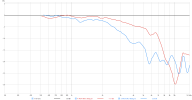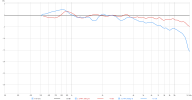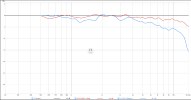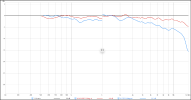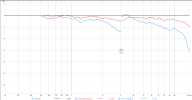Hi All, I'm no expert in speaker design, though I've learned quite a few things from lurking around here. Early this year, I finally finished a build of Troels Gravesen's Poor Man's Stradivari.
Full build photos here.
I'm in the process of converting from the passive XO to a fully active setup.
I have all of the hardware (Earthworks M23r, Focusrite Scarlett 2i2, fanless PC, 2 x AHB2s, 2 x Hypex Nilai 500 monos, Motu Ultralite Mk 5 and a Lundahl VC2361) and software (Acourate and Hang Loose Convolver) to do the active XOs and drive the speakers, but I have a few questions.
I've read a lot of discissions about directivity and waveguides. Without a tweeter waveguide, it seems the off-axis response tends to drop off significantly at higher frequencies. Also, from my reading relating to XO frequencies and acoustic centres, the mid/tweeter centre to centre should dictate the XO frequency.
Given that with Acourate-derived XOs, I have more or less carte-blanche, should I consider waveguiding the tweeter (I'm open to alternatives to the Seas 27TFFC) and reducing the mid/tweeter XO frequency from 3000 Hz to ~2400 Hz to take account of the 145 mm acoustic centre spacing between the mid and tweeter?

Thanks in advance.
Full build photos here.
I'm in the process of converting from the passive XO to a fully active setup.
I have all of the hardware (Earthworks M23r, Focusrite Scarlett 2i2, fanless PC, 2 x AHB2s, 2 x Hypex Nilai 500 monos, Motu Ultralite Mk 5 and a Lundahl VC2361) and software (Acourate and Hang Loose Convolver) to do the active XOs and drive the speakers, but I have a few questions.
I've read a lot of discissions about directivity and waveguides. Without a tweeter waveguide, it seems the off-axis response tends to drop off significantly at higher frequencies. Also, from my reading relating to XO frequencies and acoustic centres, the mid/tweeter centre to centre should dictate the XO frequency.
Given that with Acourate-derived XOs, I have more or less carte-blanche, should I consider waveguiding the tweeter (I'm open to alternatives to the Seas 27TFFC) and reducing the mid/tweeter XO frequency from 3000 Hz to ~2400 Hz to take account of the 145 mm acoustic centre spacing between the mid and tweeter?
Thanks in advance.
Last edited:

